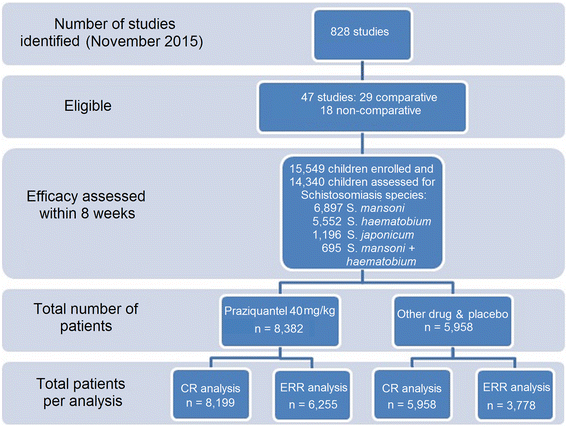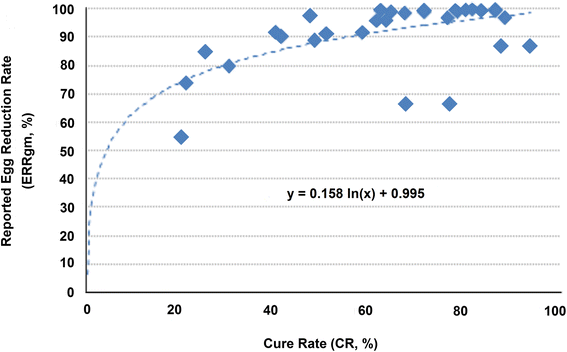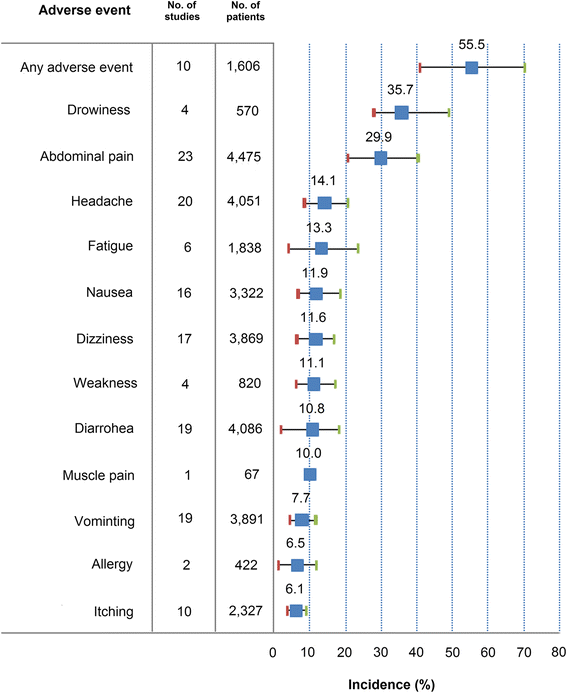Efficacy and safety of praziquantel 40 mg/kg in preschool-aged and school-aged children: a meta-analysis
- PMID: 28126024
- PMCID: PMC5270314
- DOI: 10.1186/s13071-016-1958-7
Efficacy and safety of praziquantel 40 mg/kg in preschool-aged and school-aged children: a meta-analysis
Abstract
Background: Children carry most of the schistosomiasis burden. While school-aged children are the principal target group of preventive chemotherapy with praziquantel, limited information on efficacy and safety exists for preschool-aged children.
Methods: Here, we conducted a meta-analysis of clinical trials of praziquantel for treating children with any form of schistosomiasis. Efficacy was reported as cure rate (CR) and egg reduction rates (ERR); statistical corrections were applied based on methodological disparities across trials to derive the predicted geometrical mean ERR (pERRgm). Safety was reported as frequencies of adverse events.
Results: Forty-seven comparative and non-comparative studies were identified, enrolling 15,549 children of whom 14,340 (92%) were assessed between 3 and 8 weeks post-treatment with praziquantel 40 mg/kg (the WHO-recommended treatment, n = 8,380, 56%) or comparators (n = 5,960, 44%). The median age was 10 years (range 1-19), 11% (n = 1,694) were preschool-aged. The CR and pERRgm with praziquantel 40 mg/kg were respectively: S. haematobium, 73.6% (95% CI: 63.5-81.40, 25 study arms) and 94.7% (95% CI: 92.7-96.4); S. mansoni, 76.4% (95% CI: 71.5-81.0, 34 arms) and 95.3% (95% CI: 94.2-96.2); S. mansoni/S. haematobium, 67.6% (95% CI: 54.1-80.7, 5 arms) and 93.4% (95% CI: 89.9-96.2); S. japonicum, 94.7% (95% CI: 92.2-98.0) and 98.7% (95% CI: 98.3-99.2). Mixed-effect multivariate analysis found no significant difference between preschool- and school-aged children for CR or pERRgm in S. haematobium (P = 0.309 and P = 0.490, respectively) or S. mansoni (P = 0.982 and P = 0.895) after controlling for time of assessment, formulation, intensity of infection and detection method. Praziquantel was reportedly safe at all ages, with only mild reported adverse events which cleared rapidly after treatment.
Conclusions: Praziquantel 40 mg/kg was effective at reducing infection intensity in all Schistosoma species without differences between preschool- and school-aged children. However, conclusions should be tempered because of the limited number of preschool-aged children enrolled, disparities in study procedures and limited information made available in publications, as well as the current imperfect test-of-cure. Also, although reportedly well-tolerated, safety was inconsistently assessed. Studies in target groups, individual-data meta-analysis and standardised methodologies are needed for more robust evidence-base.
Keywords: Efficacy; Praziquantel; Preschool-aged children; Safety; Schistosomiasis; School-aged children.
Figures




References
-
- World Health Organization. Preventive chemotherapy in human helminthiasis: coordinated use of anthelminthic drugs in control interventions: a manual for health professionals and programme managers. 2006. Available: http://whqlibdoc.who.int/publications/2006/9241547103_eng.pdf (Accessed 2 May 2014).
-
- World Health Organization. Assessing the Efficacy of Anthelminthic Drugs Against Schistosomiasis and Soil-Transmitted Helminthiases. 2013. Available: http://apps.who.int/iris/bitstream/10665/79019/1/9789241564557_eng.pdf (Accessed June 2016).
-
- World Health Organization. Report of a meeting to review the results of studies on the treatment of schistosomiasis in pre-school-age children. 2010. Available: http://whqlibdoc.who.int/publications/2011/9789241501880_eng.pdf (Accessed 2 May 2014).
Publication types
MeSH terms
Substances
Grants and funding
LinkOut - more resources
Full Text Sources
Other Literature Sources

